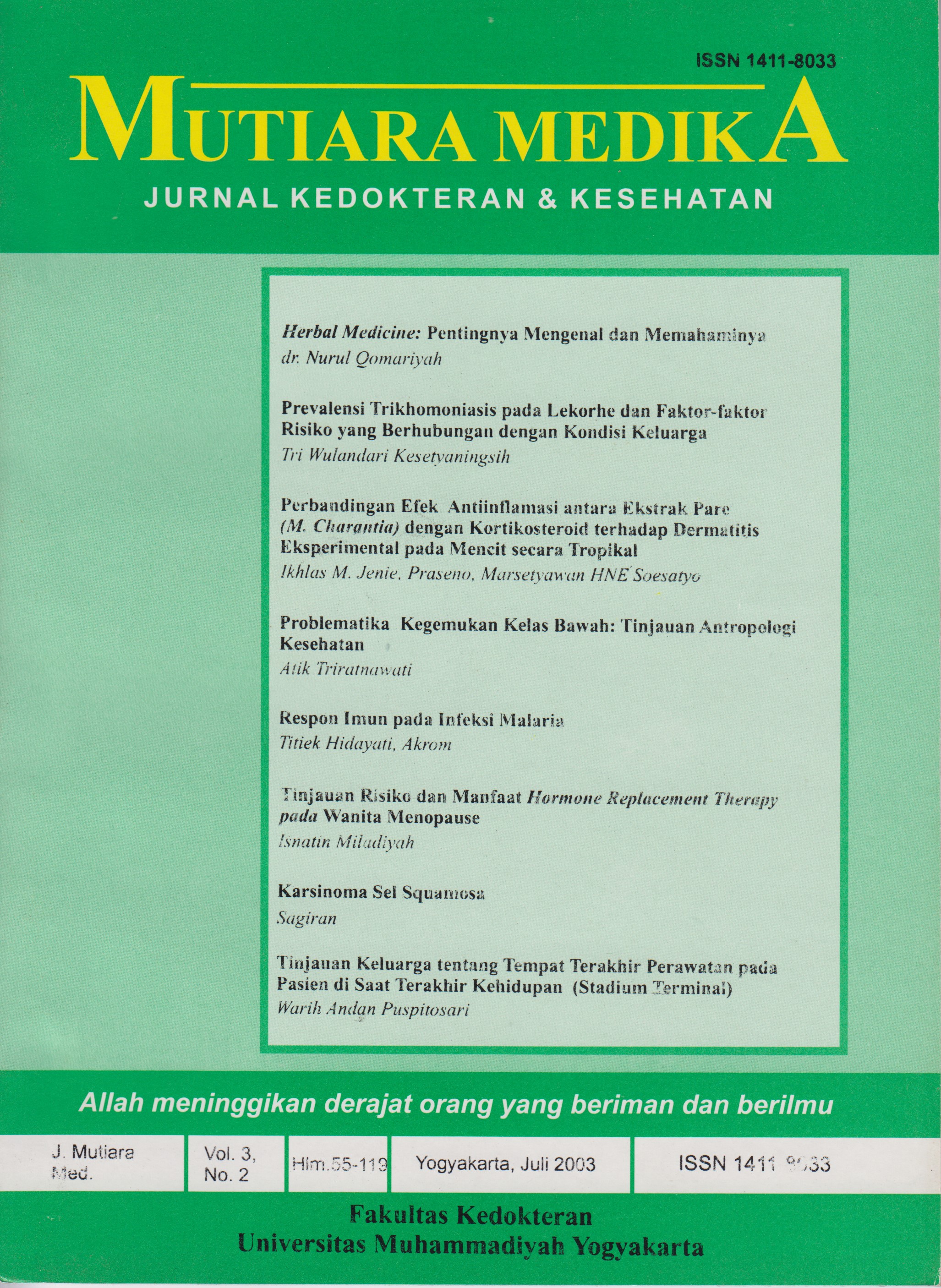Prevalensi Trikhomoniasis pada Lekorhe dan Faktor-faktor Risiko yang Berhubungan dengan Kondisi Keluarga
DOI:
https://doi.org/10.18196/mmjkk.v3i2.1705Keywords:
lekorhe, Trichomonasi vaginalis, faktor risiko, leukhorhea, Trichomonas vaginalis, risk factorAbstract
Leukhorhea is defined as the increasing of vaginal secretion. This condi¬tion occurs by both of physiological and pathological reason. Pathologi¬cally leukhorhea is particularly due to Candida albicans and Trichomonas vaginalis infection. There are many factors influence both of physiological or pathological leukhorhea. The purpose of of this research is to know prevalence of leukhorhea caused by trichomoniasis andto find the risk factors related with family condition.. The sample was carried out by vaginal swab to 93 women with leukhorhea attended Puskesmas Wates, Kulon Progo, Yogyakarta. Laboratory examina¬tion was done by using direct method. The result shows that prevalence of trichomoniasis is 33,3%. The relation of risk factors with trichomoniasis prevalence has satistically been analized by chi-square method. It shows that prevalence of trichomoniasis influenced with age, sexual activity, the user of vaginal cleanser, pregnancy, using cer¬tain contraception and is not influenced with education grade, family hygiene and sanitation facility and chronic disease suffered.
Keputihan adalah terjadinya peningkatan pengeluaran sekret vagina. Keputihan bapat bersifat fisiologis maupun patologis. Keputihan yang patologis disebut lekorhe, kebanyakan disebabkan oleh infeksi jamur Cancida albicans dan parasit Trichomo¬nas vaginalis. Banyak faktor yang berpengaruh pada terjadinya keputihan, baik yang fisiologis maupun yang patologis. Penelitian ini bertujuan untuk mengetahui prevalensi trichomoniasis pada wanita penderita lekorhe dan faktor-faktor risiko jang berkaitan dengan kondisi keluarga. Sampel diambil dari sekret vagina dari 93 wanita yang mengeluh keputihan dari pasien pengunjung Puskesmas Watcs, Kulon Progo, kemudian dilakukan pemeriksaan mikroskopis secara langsung dengan larutan NaCl fisiologis untuk melihat adanya trofozoit Trichomonas vaginalis. Hasil penelitian menunjukkan prevalensi trichomo-niasis pada lekorhe adalah 33,3 % dari sampel yang diperiksa. Hubungan faktor- faktor risiko yang diteliti dengan prevalensi trichomoniasis dianalisis dengan chi- square menunjukkan bahwa trichomoniasis dipengaruhi oleh faktor umur, aktivitas seksual, penggunaan pembersih vagina, kehamilan, penggunaan alat KB dan tidak terpengaruh oleh faktor tingkat pendidikan, fasilitas hygiene sanitasi keluarga dan penyakit kronis.
References
Anonim, 1998. About vaginal health. National Vaginitis Association Disclaimer 3 M Center, 275- 3W-01 P.O.Box 33275, MN 55133-3275
Siregar, R.S., 1995. Penyakit Jamur Kulit. Laboratorium Ilmu Penyakit Kulit Kelamin. FK. UNSRI/RSU Palembang.
Anonim, 1992. Vaginal Infections And Vaginitis. Office of Communications National Institute of Allergy and Infectious Disease National Institutes of Health Bethesda, Maryland 20892.
Beaver P.C., R.C. Jung dan E. W. Cupp. 1984. Clinical Parasitology. 9*.Ed.Philadelphia., Lea and Febiger.
Brown, M.T.. 1972. Trichomoniasis. Practitioner.209:639-644
Garcia, L.S. dan D.A. Bruckner. 1995. Diagnostik Parasitologi Kedokteran. Editor L. Padmasutra., EGC. Jakarta. 62-63
Unzcitig,V., 1999. Sexually transmitted disease and contraception. Htpp://www.kenes.com/ cogibook
Mahdi. N.K., 1996. Urogenital Trichomoniasis in an Iraqi population. htpp://www.emro.who.int/ publication/emj//0203/18.htm
Wilson, R., 2002. Trichomoniasis. htpp://www.emedicine.com/ped/topic2291 .htm
Downloads
Published
Issue
Section
License
Copyright
Authors retain copyright and grant Mutiara Medika: Jurnal Kedokteran dan Kesehatan (MMJKK) the right of first publication with the work simultaneously licensed under an Attribution 4.0 International (CC BY 4.0) that allows others to remix, adapt and build upon the work with an acknowledgment of the work's authorship and of the initial publication in Mutiara Medika: Jurnal Kedokteran dan Kesehatan (MMJKK).
Authors are permitted to copy and redistribute the journal's published version of the work (e.g., post it to an institutional repository or publish it in a book), with an acknowledgment of its initial publication in Mutiara Medika: Jurnal Kedokteran dan Kesehatan (MMJKK).
License
Articles published in the Mutiara Medika: Jurnal Kedokteran dan Kesehatan (MMJKK) are licensed under an Attribution 4.0 International (CC BY 4.0) license. You are free to:
- Share — copy and redistribute the material in any medium or format.
- Adapt — remix, transform, and build upon the material for any purpose, even commercially.
This license is acceptable for Free Cultural Works. The licensor cannot revoke these freedoms as long as you follow the license terms. Under the following terms:
Attribution — You must give appropriate credit, provide a link to the license, and indicate if changes were made. You may do so in any reasonable manner, but not in any way that suggests the licensor endorses you or your use.
- No additional restrictions — You may not apply legal terms or technological measures that legally restrict others from doing anything the license permits.



